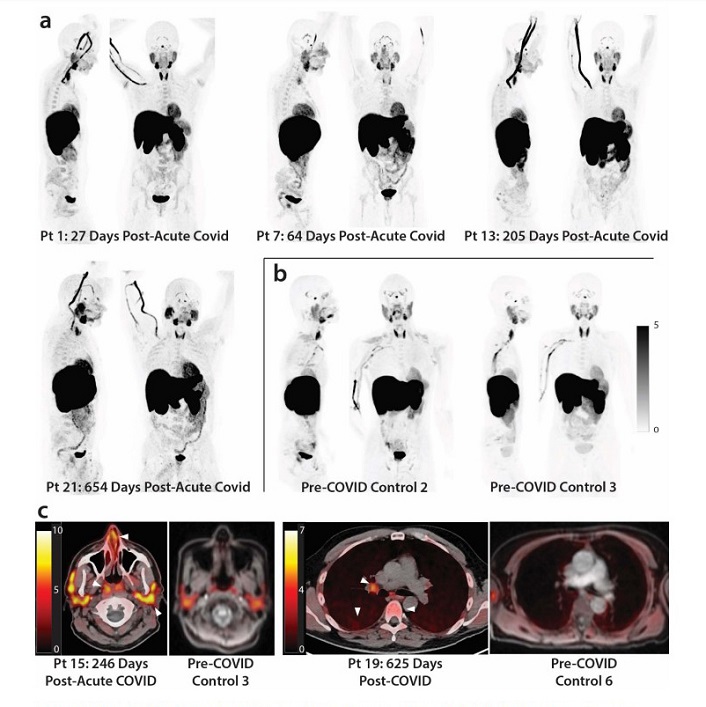COVID-19's Lingering Impact: T Cell Activation and Viral Persistence Up to Two Years
Nikhil Prasad Fact checked by:Thailand Medical News Team Jul 04, 2024 9 months, 3 weeks, 1 day, 1 hour, 27 minutes ago
Long COVID News: The aftermath of COVID-19 continues to puzzle scientists and doctors. While some people recover fully, others experience long-lasting symptoms known as Long COVID. A recent study led by researchers at the University of California San Francisco (UCSF) that is covered in this
Long COVID News report, sheds light on why some individuals might not bounce back as quickly. This study reveals how COVID-19 affects the body at a cellular level, showing persistent T cell activation and the presence of viral RNA in tissues up to two years post-infection.
 [18F]F-AraG PET and PET/CT images from participants following COVID-19 and pre-pandemic control volunteers. Maximum intensity projections (MIP; coronal and sagittal views of 3-dimesional reconstructions) are shown for four representative participants at various times following SARS-CoV-2 infection (a) and male and female uninfected controls (b). Axial PET/CT overlay images are shown in (c) showing increased signal in nasal turbinates, parotid glands, hilar lymph node, lung parenchyma, and lumbar bone marrow in representative post-acute COVID and pre-pandemic control participants (white arrows).
What Is Long COVID?
[18F]F-AraG PET and PET/CT images from participants following COVID-19 and pre-pandemic control volunteers. Maximum intensity projections (MIP; coronal and sagittal views of 3-dimesional reconstructions) are shown for four representative participants at various times following SARS-CoV-2 infection (a) and male and female uninfected controls (b). Axial PET/CT overlay images are shown in (c) showing increased signal in nasal turbinates, parotid glands, hilar lymph node, lung parenchyma, and lumbar bone marrow in representative post-acute COVID and pre-pandemic control participants (white arrows).
What Is Long COVID?
Long COVID, or post-acute sequelae of SARS-CoV-2 infection (PASC), refers to a range of symptoms that linger long after the acute phase of COVID-19. These symptoms can include fatigue, brain fog, shortness of breath, and more. The Centers for Disease Control and Prevention (CDC) estimates that approximately 15% of American adults have experienced Long COVID, with about 6% currently dealing with its effects.
The Study at a Glance
The UCSF study involved 24 participants who had recovered from the acute phase of COVID-19. These individuals underwent whole-body PET imaging, which uses a special tracer called [18F]F-AraG to detect activated T cells. T cells are a type of immune cell that helps the body fight infections. By using this tracer, researchers could see where in the body T cells were still active, indicating ongoing immune responses.
Key Findings
The study found that participants who had recovered from COVID-19 showed higher levels of T cell activation in several parts of the body compared to pre-pandemic controls. This activation was particularly notable in areas such as the brain stem, spinal cord, bone marrow, lungs, and gut. Interestingly, T cell activation was observed even in participants who were imaged up to 2.5 years after their initial COVID-19 infection.
Persistent Symptoms and T Cell Activation
One of the significant findings was the link between T cell activation and Long COVID symptoms. Participants with Long COVID symptoms showed higher T cell activation in their spinal cord and gut wall. Additionally, those with ongoing pulmonary symptoms had increased T cell activation in their lung tissue. This suggests that persistent immune responses in these areas might contribute to the prolonged symptoms experienced by Long COVID sufferers.
Viral RNA Pers
istence
Another crucial discovery was the presence of SARS-CoV-2 RNA in the gut tissues of participants with Long COVID symptoms. Researchers found viral RNA in the rectosigmoid tissue of all participants who underwent biopsies, even up to 676 days post-infection. This persistence of viral RNA could be a key factor in the ongoing immune activation and inflammation observed in these individuals.
The Implications
These findings have significant implications for our understanding of COVID-19 and its long-term effects. The persistence of T cell activation and viral RNA in tissues suggests that COVID-19 is not just an acute illness but can have long-lasting impacts on the body. This ongoing immune response might be driving the chronic symptoms seen in Long COVID.
Looking Ahead
While this study provides valuable insights, it also raises several questions. For instance, why do some individuals experience these prolonged immune responses while others do not? More research is needed to understand the mechanisms behind these persistent symptoms and to develop effective treatments for Long COVID.
Conclusion
The UCSF study offers a deeper understanding of the lingering effects of COVID-19, showing how the virus can continue to impact the body long after the initial infection. Persistent T cell activation and viral RNA in tissues highlight the need for ongoing research and targeted treatments to help those suffering from Long COVID. As we continue to navigate the COVID-19 pandemic, studies like this are crucial in unraveling the complexities of the virus and its long-term effects on human health.
By shedding light on the cellular and molecular changes in the body post-COVID, this research brings us one step closer to addressing the challenges posed by Long COVID and improving the lives of those affected.
The study findings were published in the peer reviewed journal: Science Translational Medicine.
https://www.science.org/doi/10.1126/scitranslmed.adk3295
For the latest
Long COVID News, keep on logging to Thailand Medical News.
Read Also:
https://www.thailandmedical.news/news/scientists-warn-that-viral-persistence-is-the-primary-contributing-factor-to-long-covid
https://www.thailandmedical.news/news/study-shows-that-sars-cov-2-evolutionary-and-mutation-rate-is-not-enhanced-by-immunodeficiencies-but-rather-by-viral-persistence
